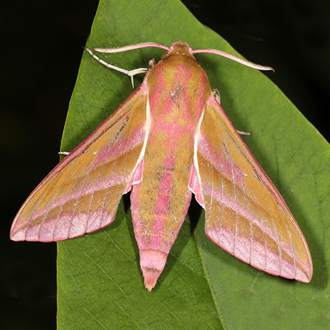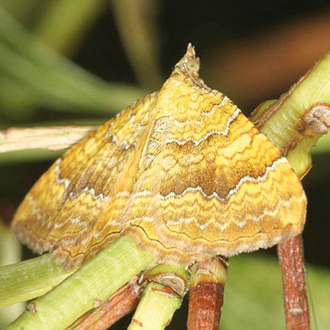
 |
 |
 |
 |
 |
 |
 |
 |
 |
 |
 |
 |
 |
 |
 |
 |
 |
 |
 |
 |
 |
|
Poplar Hawk-moth (Laothoe populi, wingspan 60mm) and Lime Hawk-moth (Mimas tiliae, wingspan 65mm) are two which are pretty common in residential areas, emerging around May or June. The former feeds on Poplar, Aspen and Willow among others. The Lime Hawk-moth feeds on cultivated Maple (Acer spp) and Birch as well the tree after which it is named. There were more Elephant Hawk-moths (Deilephila elpenor, wingspan 55mm) taken in the trap than any of the family, seven. They have an exceptionally dashing livery and the larvae use mostly Willowherbs and Bedstraws. Just one Pine Hawk-moth (Sphinx pinastri, wingspan 55mm) appeared in the trap. As the name suggests, this moth's larvae feed mostly on Scots Pine although other conifers can be used. It is essentially a species of lowland England. Tigers, especially the Garden Tiger (Arctia caja), are among the best-loved of our moths and among the brightest in colouration. Two Ruby Tigers (Phragmatobia fuliginosa fuliginosa, wingspan 25mm) appeared in the trap. This is a widespread and pretty common species that feeds on a wide range of herbaceous plants. The Scarce Silver-lines (Bena bicolorana, wingspan 28mm) feeds chiefly on Pendunculate Oak and is widespread in England and Wales. Equally attractive are the Footman moths, with 15 species in Britain. The vast majority feed on lichens and algae on trees, bushes and other plants. Five of the 15 went into the light trap including two of the more brightly coloured ones in the Orange Footman (Eilema sororcula, wingspan 20mm) and the Rosy Footman (Miltochrista miniata, wingspan 20mm). The intriguingly shaped Pebble Hook-tip (Drepana falcataria, wingspan 28mm) is the commonest of five Hook-tips in our fauna. The caterpillars feed mainly on birches, a comment which also applies to one of the hairiest moths in the list, the brilliant yellow Canary-shouldered Thorn (Ennomos alniaria, wingspan 25mm). This stunning species is widespread and frequently found. Equally common is the bonny Green Carpet (Colostygia pectinataria, wingspan 18mm), one of many species with the word Carpet in the vernacular name. This one uses various Bedstraws as food. Two black and white moths which entered my trap are the Peppered Moth (Biston betularia, wingspan 35mm) and the Black Arches (Lymantria monacha, wingspan 35mm) The former is widespread with a wide range of foodplants but Black Arches is found only in southern Britain and feeds chiefly on varieties of Oak. Much brighter in hue is the Merveille du Jour (Griposia aprilina, wingspan 30mm), one of the handsomest of the noctuid moths and a relatively late flier, emerging in September. The larva - the pictured specimen was photographed in the New Forest in May 2017 - feeds on various types of Oak. The camouflage of this larva was exceptional and many adult moths are at least as efficient in this. The Buff Tip (Phalera bucephala, wingspan 35mm) does a splendid imitation of a birch twig. The face is decidedly broad. This is the only member of the Phalerinae resident in Britain and uses a variety of deciduous trees as foodplants led by Sallow, Silver Birch, Oak and Hazel. The Dot (Melanchra persicariae, wingspan 26mm) is pretty catholic in its diet. Habitually day-flying moths form a decided minority of our fauna but there are still plenty to admire. The Yellow Shell (Camptogramma bilineata, wingspan 20mm) feeds on a wide range of plants and quite often visits flowers such as Creeping Thistle. Plume moths including Gillmeria pallidactyla (wingspan 28mm) hold their wings at right angles to the abdomen when resting. They look much more delicate than they are. The Apple-leaf Skeletonizer (Choreutis pariana, wingspan 13mm) can target commercial crops but often goes for Crab-apple, and the Silver-Y (Autographa gamma, wingspan 26mm) migrates to Britain in large numbers most years. A small but, with the male, spectacular moth is the long-horned moth Nemophora degeerella (wingspan 15mm). The antennae in the male are prodigious and the species can look wonderful when swarming in the spring. The Horse-chestnut Leaf-miner (Cameraria ohridella) is a much smaller species, with a wingspan of only 10mm, but it makes up for lack of size with big publicity. This is almost entirely negative since its larvae feed on Horse-chestnut leaves, frequently turning them almost completely brown. The species was first discovered in Macedonia in 1985 and has spread rapidly across Europe. However, since the damage to the leaves is done after the growing season is over, the moth is not harming the trees, even though the larvae's work looks unsightly. Leaving the best among the moths until last, clearwings are an under-recorded group of 15 species of moth nationwide whose caterpillars for the most part feed just below the bark of deciduous trees and take anything from one to three years to reach maturity. All the species are day-flying and striking in appearance, resembling Hymenoptera. Yellow-legged Clearwings (Synanthedon vespiformis, wingspan 20mm) have larvae that feed principally on Oak (Quercus sp) or Sweet Chestnut (Castania sativa). The pictured female turned up to nectar in the garden early in August 2006. The name vespiformis gives it away, since at first sight she might be assumed to be a wasp. In 2011 a friend spotted another clearwing on a Cotoneaster bush that was in full bloom and had significant numbers of bumblebees, especially Bombus hypnorum, at work on it. The moth was a male Red-belted Clearwing (Synanthedon myopaeformis, wingspan 24mm), a southern species which flies from June to August and is associated with old fruit trees, notably apple, in which its larvae develop. Finally, in 2013 a Currant Clearwing (Synanthedon tipuliformis, wingspan 18mm) appeared on an Elm leaf up the garden. This is a relatively small species whose larvae feed on the shoots of redcurrant and blackcurrant bushes. If you are lucky enough to come across any clearwings, make the most of it. The majority of the group, including the Yellow-legged, is designated as nationally scarce. Images © Jeremy Early. All rights reserved. In 2013 I published My Side of the Fence - the Natural History of a Surrey Garden. Details may be found, and orders placed, via this hyperlink My Side of the Fence. In November 2015 Surrey Wildlife Trust published the atlas Soldierflies, their allies and Conopidae of Surrey, jointly written by David Baldock and me. Details are on this web page: Atlas. |